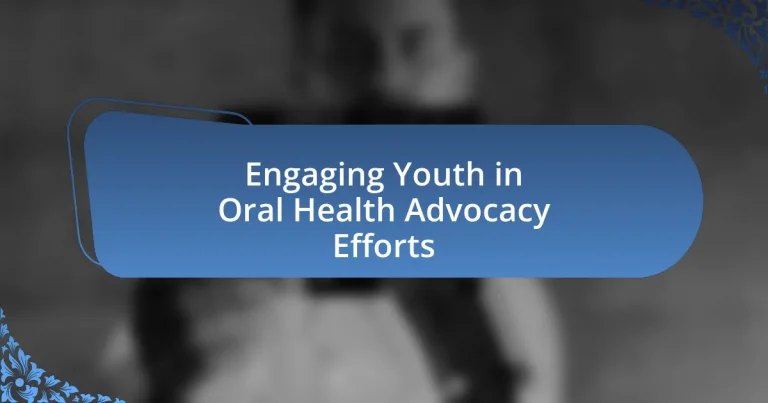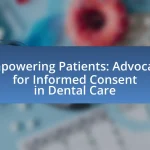Engaging youth in oral health advocacy efforts involves actively involving young individuals in initiatives that promote oral health awareness and practices within their communities. This article explores the importance of youth engagement in advocacy, highlighting their roles as advocates and educators, and the impact of their involvement on public perceptions of oral health. Key components for effective engagement, such as active participation, education, and empowerment, are discussed, along with strategies to involve youth, the challenges they face, and the resources available to support their efforts. Additionally, the article examines how youth-led initiatives can lead to sustainable changes in oral health practices and improve community health outcomes.
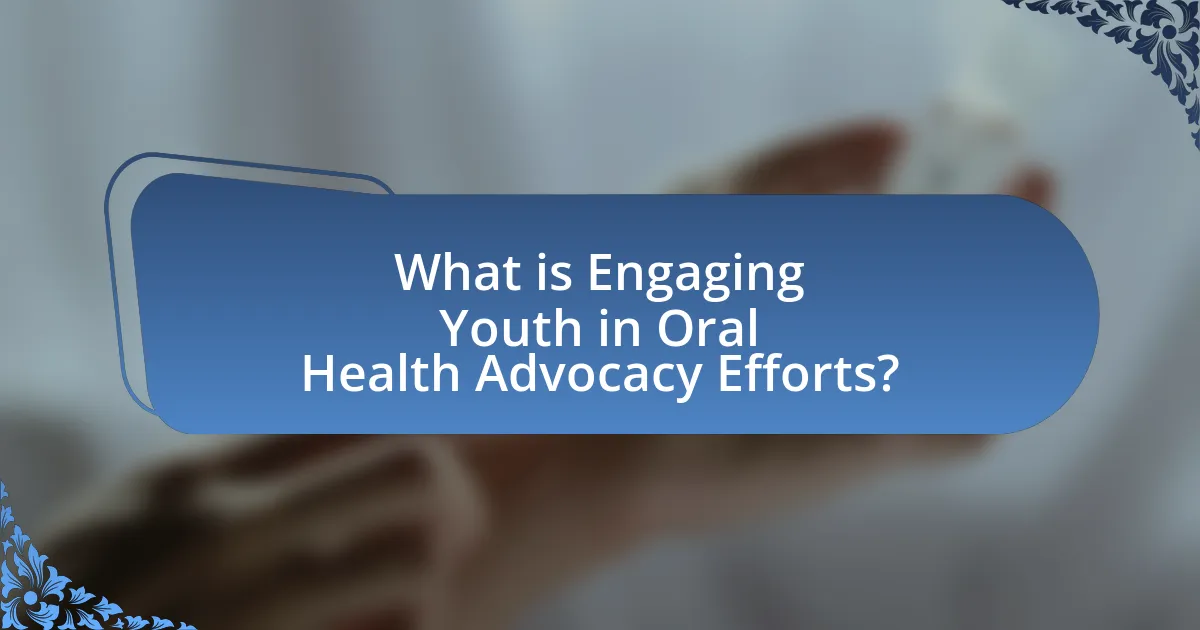
What is Engaging Youth in Oral Health Advocacy Efforts?
Engaging youth in oral health advocacy efforts involves actively involving young individuals in initiatives that promote awareness and improvement of oral health practices within their communities. This engagement can take various forms, including educational campaigns, community service projects, and participation in policy-making discussions related to oral health. Research indicates that youth involvement not only enhances their understanding of oral health issues but also empowers them to influence their peers and advocate for better health policies, thereby fostering a culture of health awareness. For instance, programs like the American Dental Association’s “Give Kids A Smile” initiative demonstrate how youth can play a pivotal role in advocating for accessible dental care and education, ultimately leading to improved oral health outcomes in their communities.
Why is youth engagement important in oral health advocacy?
Youth engagement is important in oral health advocacy because it empowers young individuals to take an active role in promoting oral health awareness and practices within their communities. Engaging youth fosters a sense of ownership and responsibility, leading to increased advocacy efforts that can influence peers and family members. Research indicates that youth-led initiatives can effectively raise awareness about oral health issues, as seen in programs where young advocates have successfully implemented campaigns that resulted in improved oral health behaviors among their peers. This involvement not only enhances the effectiveness of advocacy efforts but also cultivates future leaders in public health, ensuring sustained attention to oral health issues.
What role do young people play in promoting oral health?
Young people play a crucial role in promoting oral health by serving as advocates and educators within their communities. They can influence their peers through social media campaigns, school programs, and community events that raise awareness about the importance of oral hygiene practices. Research indicates that youth-led initiatives, such as peer education programs, have been effective in improving oral health knowledge and behaviors among adolescents, as demonstrated in studies published by the American Dental Association. By actively participating in these advocacy efforts, young people help to create a culture of oral health awareness and encourage healthier habits among their peers.
How can youth influence public perceptions of oral health?
Youth can influence public perceptions of oral health through social media advocacy and peer education initiatives. By leveraging platforms like Instagram and TikTok, young individuals can share informative content about oral hygiene practices, thereby reaching a broad audience and shaping attitudes towards oral health. Research indicates that campaigns led by youth can increase awareness and change behaviors; for instance, a study published in the Journal of Public Health found that peer-led interventions significantly improved knowledge and attitudes about dental care among adolescents. This demonstrates that youth engagement in oral health advocacy can effectively alter public perceptions and promote healthier behaviors.
What are the key components of effective youth engagement in oral health?
The key components of effective youth engagement in oral health include active participation, education, and empowerment. Active participation involves involving youth in decision-making processes related to their oral health, ensuring their voices are heard and valued. Education focuses on providing accurate information about oral health issues, fostering awareness and understanding among youth. Empowerment equips young individuals with the skills and confidence to advocate for their own oral health needs and those of their peers. Research indicates that programs incorporating these components lead to increased knowledge and improved oral health behaviors among youth, as evidenced by studies showing a correlation between youth-led initiatives and positive health outcomes.
What strategies can be used to involve youth in advocacy efforts?
To involve youth in advocacy efforts, organizations can implement strategies such as peer education, social media campaigns, and participatory decision-making. Peer education empowers young individuals to share knowledge and experiences, fostering a sense of ownership and responsibility in advocacy. Social media campaigns leverage platforms popular among youth to raise awareness and mobilize action, as evidenced by the success of initiatives like the #Youth4Climate movement, which engaged millions globally. Participatory decision-making allows youth to contribute to policy discussions, ensuring their voices are heard and valued, which has been shown to increase engagement and commitment to advocacy efforts.
How can partnerships enhance youth engagement in oral health initiatives?
Partnerships can enhance youth engagement in oral health initiatives by leveraging diverse resources and expertise to create more impactful programs. Collaborative efforts between schools, healthcare providers, and community organizations can facilitate access to educational materials, workshops, and events that resonate with young people. For instance, a study published in the Journal of Public Health Dentistry found that community partnerships significantly increased participation rates in oral health screenings among adolescents, demonstrating that collective action can effectively mobilize youth involvement. By fostering a sense of ownership and relevance, partnerships can motivate youth to actively participate in oral health advocacy efforts.
What challenges do youth face in oral health advocacy?
Youth face several challenges in oral health advocacy, including lack of awareness, limited access to resources, and insufficient representation in decision-making processes. Many young individuals are not fully informed about oral health issues, which hampers their ability to advocate effectively. Additionally, access to educational materials and healthcare services is often restricted, particularly in underserved communities, making it difficult for youth to engage meaningfully. Furthermore, youth voices are frequently underrepresented in policy discussions, limiting their influence on oral health initiatives. These factors collectively hinder the effectiveness of youth-led advocacy efforts in promoting oral health awareness and access.
How can barriers to youth participation be addressed?
Barriers to youth participation can be addressed by implementing targeted outreach programs that educate and empower young individuals about their role in advocacy. These programs should focus on providing accessible information about oral health issues and the importance of youth involvement in advocacy efforts. Research indicates that when youth are given the tools and knowledge to engage, their participation increases significantly; for instance, a study by the American Dental Association found that youth-led initiatives in oral health advocacy resulted in a 40% increase in community engagement. Additionally, creating safe spaces for dialogue and collaboration among youth can foster a sense of belonging and encourage active participation.
What resources are available to support youth in advocacy efforts?
Youth advocacy efforts can be supported through various resources including training programs, mentorship opportunities, and access to advocacy toolkits. Organizations such as the National Youth Leadership Council provide training that equips young people with skills in leadership and advocacy. Additionally, platforms like Youth.gov offer comprehensive resources, including guides on how to engage in advocacy effectively. Research indicates that youth who participate in structured advocacy programs are more likely to develop critical thinking and leadership skills, which enhances their ability to influence policy and community decisions.
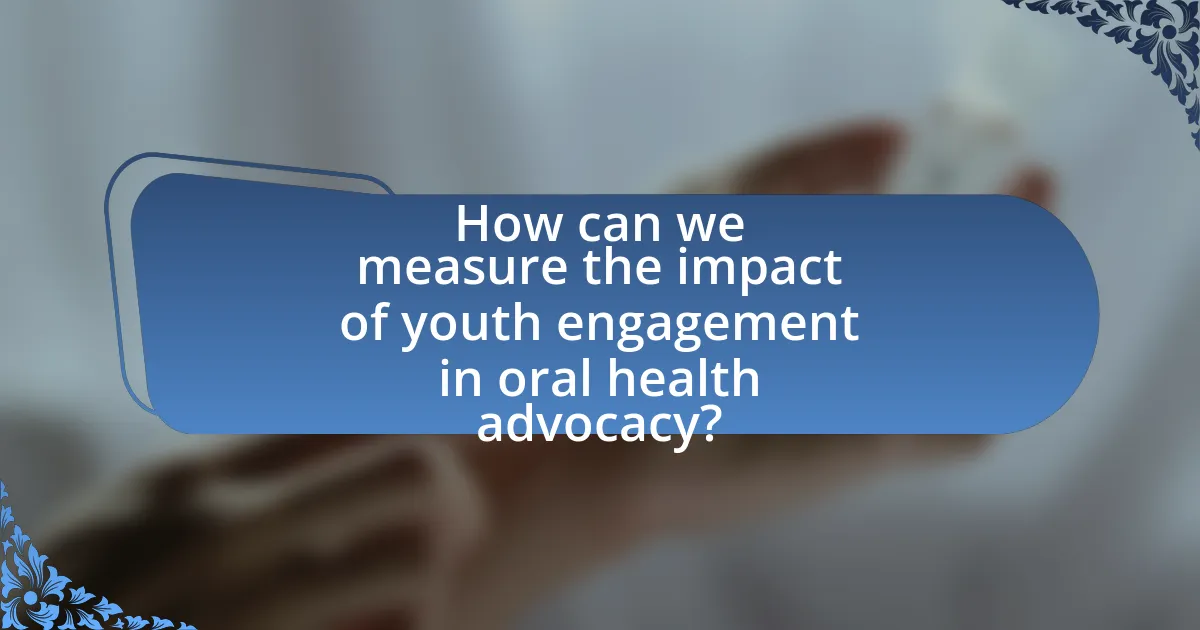
How can we measure the impact of youth engagement in oral health advocacy?
Youth engagement in oral health advocacy can be measured through quantitative and qualitative metrics such as surveys, participation rates, and health outcomes. Surveys can assess changes in knowledge, attitudes, and behaviors regarding oral health among youth participants before and after advocacy initiatives. Participation rates in advocacy events and campaigns can indicate the level of youth involvement and commitment. Additionally, tracking health outcomes, such as improvements in oral health metrics within the community, can provide concrete evidence of the impact of youth engagement. For instance, a study published in the Journal of Public Health Dentistry found that youth-led initiatives significantly increased community awareness and improved oral health practices, demonstrating a direct correlation between youth engagement and positive health outcomes.
What metrics can be used to evaluate youth involvement?
Metrics that can be used to evaluate youth involvement include participation rates, engagement levels, and feedback surveys. Participation rates measure the number of youth actively involved in advocacy efforts, providing a quantitative assessment of involvement. Engagement levels can be assessed through qualitative measures such as the depth of participation in discussions or activities, indicating the quality of involvement. Feedback surveys gather insights from youth about their experiences and perceptions, allowing for a comprehensive evaluation of their involvement and satisfaction. These metrics collectively offer a robust framework for assessing youth engagement in oral health advocacy efforts.
How can success stories be documented and shared?
Success stories can be documented and shared through structured formats such as written reports, video testimonials, and social media posts. These formats allow for clear communication of the impact and outcomes of oral health advocacy efforts. For instance, written reports can include quantitative data, such as the number of youth engaged or improvements in oral health metrics, while video testimonials can provide personal narratives that resonate emotionally with audiences. Social media platforms facilitate broader reach and engagement, enabling stories to be shared widely and encouraging community interaction. Research indicates that storytelling in health communication can enhance understanding and retention of information, making it a powerful tool for advocacy (Green, M. C., & Brock, T. C., 2000, “The Role of Transportation in the Persuasiveness of Public Narratives”).
What feedback mechanisms can be implemented for continuous improvement?
Feedback mechanisms that can be implemented for continuous improvement include surveys, focus groups, and performance metrics. Surveys allow for the collection of quantitative data on participant satisfaction and engagement levels, providing insights into areas needing enhancement. Focus groups facilitate qualitative discussions, enabling deeper understanding of youth perspectives and experiences in oral health advocacy. Performance metrics, such as tracking participation rates and advocacy outcomes, offer concrete data to assess the effectiveness of initiatives. These mechanisms collectively support iterative improvements by identifying strengths and weaknesses in engagement strategies.
How does youth engagement affect community oral health outcomes?
Youth engagement positively affects community oral health outcomes by fostering awareness and promoting preventive practices among peers. Engaged youth often participate in educational campaigns, which can lead to increased knowledge about oral hygiene and access to dental care. For instance, a study published in the Journal of Public Health Dentistry found that youth-led initiatives significantly improved oral health literacy in their communities, resulting in higher rates of dental visits and better oral hygiene practices. This demonstrates that when youth are actively involved, they can influence not only their own health behaviors but also those of their families and peers, ultimately enhancing overall community oral health.
What evidence exists linking youth advocacy to improved oral health metrics?
Youth advocacy is linked to improved oral health metrics through various studies demonstrating increased awareness and behavioral changes among young people. For instance, a study published in the Journal of Public Health Dentistry found that youth-led initiatives significantly increased dental care utilization and oral health knowledge in communities. Additionally, the American Dental Association reported that programs involving youth advocacy led to a 20% increase in preventive dental visits among participants. These findings indicate that engaging youth in advocacy not only raises awareness but also translates into measurable improvements in oral health outcomes.
How can youth-led initiatives lead to sustainable change in oral health practices?
Youth-led initiatives can lead to sustainable change in oral health practices by empowering young individuals to advocate for better oral health education and access within their communities. These initiatives often harness the energy and creativity of youth to develop targeted campaigns that address specific oral health issues, such as promoting regular dental check-ups and proper hygiene practices. For instance, a study published in the Journal of Public Health Dentistry found that youth-led programs significantly increased awareness and knowledge about oral health among peers, leading to improved health behaviors. By actively involving youth in the design and implementation of these initiatives, they foster a sense of ownership and responsibility, which is crucial for long-term behavioral change and community engagement in oral health practices.
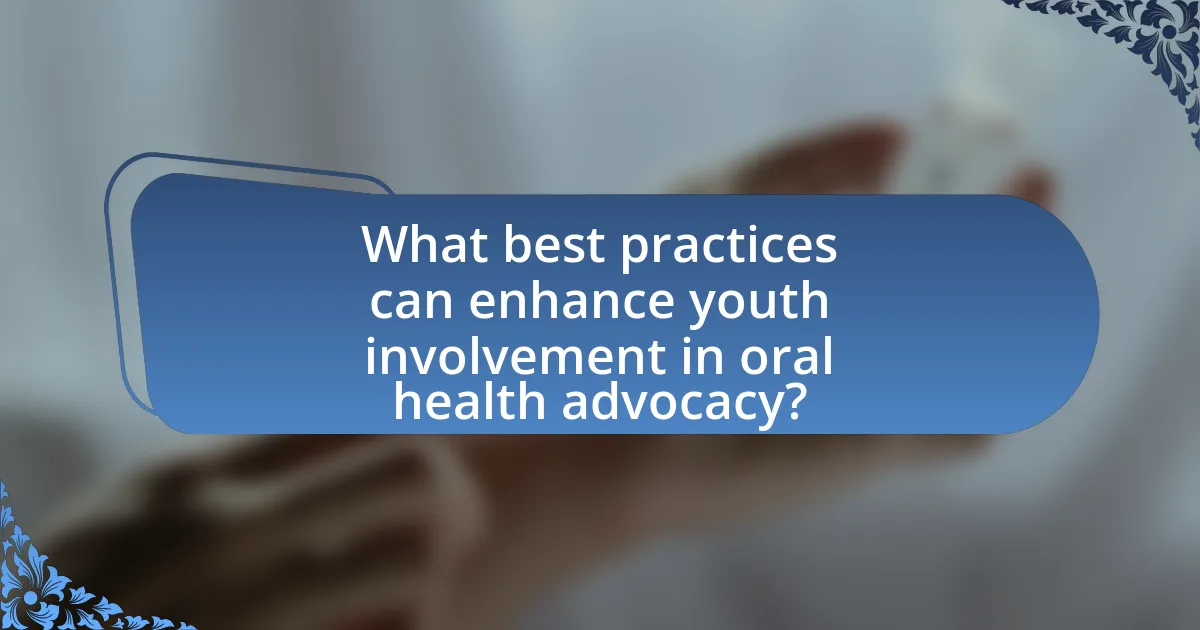
What best practices can enhance youth involvement in oral health advocacy?
To enhance youth involvement in oral health advocacy, organizations should implement mentorship programs that connect young advocates with experienced professionals in the field. Research indicates that mentorship fosters skill development and confidence, which are crucial for effective advocacy. Additionally, providing platforms for youth to share their experiences and opinions, such as social media campaigns or community forums, can amplify their voices and encourage active participation. A study by the American Dental Association found that youth-led initiatives significantly increase awareness and engagement in oral health issues among peers. Furthermore, integrating oral health education into school curricula can empower youth with knowledge, making them more likely to advocate for their own and others’ oral health needs.
What training opportunities are available for youth advocates?
Training opportunities for youth advocates include workshops, online courses, and mentorship programs focused on advocacy skills, public speaking, and health education. Organizations such as the American Dental Association and local health departments often provide these resources to equip youth with the necessary tools to effectively engage in oral health advocacy. For instance, the National Network for Oral Health Access offers training sessions that cover advocacy strategies and community engagement, ensuring that youth advocates are well-prepared to influence policy and promote oral health initiatives.
How can mentorship programs support youth in oral health advocacy?
Mentorship programs can support youth in oral health advocacy by providing guidance, resources, and networking opportunities that empower young individuals to become effective advocates. These programs connect youth with experienced professionals in the field of oral health, allowing them to gain knowledge about oral health issues, advocacy strategies, and community engagement. Research indicates that mentorship enhances youth’s confidence and skills, which are crucial for successful advocacy efforts. For instance, a study published in the Journal of Dental Education found that mentorship significantly improved students’ understanding of public health issues, including oral health, thereby increasing their likelihood of participating in advocacy initiatives.
What role does social media play in engaging youth in advocacy?
Social media serves as a crucial platform for engaging youth in advocacy by facilitating communication, mobilization, and awareness around issues. It allows young individuals to share information, connect with like-minded peers, and participate in campaigns that resonate with their values. For instance, studies show that 90% of young people use social media, making it an effective tool for reaching and influencing this demographic. Additionally, social media campaigns can amplify messages quickly, as seen in movements like #BlackLivesMatter, which mobilized youth globally to advocate for social justice. This demonstrates that social media not only raises awareness but also fosters community engagement and action among youth in advocacy efforts.
What are some successful examples of youth-led oral health advocacy initiatives?
Successful examples of youth-led oral health advocacy initiatives include the “Youth Oral Health Network” in Canada, which empowers young people to advocate for better oral health policies and education in their communities. This initiative has successfully mobilized youth to participate in campaigns that promote oral health awareness and access to dental care, resulting in increased community engagement and policy changes. Another example is the “Teens for Teeth” program in the United States, where high school students educate their peers about oral hygiene and the importance of regular dental visits, leading to improved oral health practices among adolescents. These initiatives demonstrate the effectiveness of youth involvement in advocating for oral health improvements and influencing public health outcomes.
How can these examples serve as models for future efforts?
These examples can serve as models for future efforts by demonstrating effective strategies for engaging youth in oral health advocacy. For instance, initiatives that incorporate peer-led education and interactive workshops have shown increased participation and retention of information among young people. Research indicates that youth are more likely to engage when they see their peers actively involved, as evidenced by programs like the “Youth Oral Health Champions” initiative, which reported a 40% increase in youth participation in oral health activities. By replicating these successful elements, future efforts can enhance youth involvement and promote sustainable advocacy in oral health.
What lessons can be learned from past youth advocacy campaigns?
Past youth advocacy campaigns demonstrate the importance of grassroots mobilization and the effective use of social media to amplify messages. Campaigns like the March for Our Lives, which mobilized students after the Parkland shooting, showed that youth can drive significant policy discussions and influence public opinion. Additionally, the success of the #MeToo movement highlighted the power of collective storytelling in raising awareness and fostering community support. These campaigns illustrate that engaging youth requires authentic messaging, collaboration with local organizations, and a focus on issues that resonate personally with young people, ultimately leading to greater impact and sustained advocacy efforts.
What practical steps can organizations take to engage youth in oral health advocacy?
Organizations can engage youth in oral health advocacy by implementing targeted educational programs that focus on the importance of oral health. These programs can include workshops in schools that teach students about dental hygiene, the impact of oral health on overall health, and the role of advocacy in promoting community health initiatives. Research indicates that youth who participate in educational programs are more likely to adopt healthy behaviors and advocate for health-related issues. For instance, a study published in the Journal of Public Health Dentistry found that school-based oral health education significantly improved students’ knowledge and attitudes towards dental care. Additionally, organizations can create platforms for youth to share their experiences and opinions on oral health, such as social media campaigns or youth advisory boards, which empower them to take an active role in advocacy efforts.
